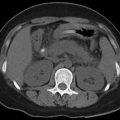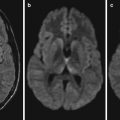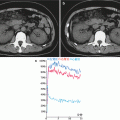© Springer Science+Business Media Dordrecht and People’s Medical Publishing House 2015
Hongjun Li (ed.)Radiology of Infectious Diseases: Volume 110.1007/978-94-017-9882-2_2727. Rubella
(1)
Department of Radiology, Beijing You’an Hospital, Capital Medical University, Beijing, China
Rubella is an acute respiratory infectious disease caused by rubella virus (RV). The acquired infection of rubella has clinical manifestations of mild respiratory tract inflammation, fever, red maculopapules, retroauricular, and occipitoposterior lymphadenectasis. Its infection in early pregnancy may cause fetal malformation or fetal death.
27.1 Etiology
Rubella virus is a positive single-stranded RNA virus, which is categorized into the family of Togaviridae. The viruses of this family are enveloped by a lipoprotein layer to maintain its activity. Electron microscopy demonstrates rubella virus in irregular sphericity with a diameter of 60–70 nm. Its two major components are an envelope and an inner nucleocapsid. On the surface of the envelope, there are protuberances in length of 5–6 nm containing prothrombin. The nucleocapsid is about 30 nm in diameter, with helical protein and a single-stranded RNA. Rubella virus contains 3–8 kinds of structural proteins, with envelope protein E1, envelope protein E2, and capsid protein C as its most important components. Both envelope protein E1 and envelope protein E2 are the transmembrane glycoprotein, while capsid protein C is a capsid protein surrounding viral RNA. The envelope protein E1 contains antigenic determinants that are related to hemagglutination activity (HA) and hemolytic activity (HL) of rubella virus. In addition, these antigenic determinants also play a role in inducing neutralizing antibody response, and the envelope protein E1 plays an important role in RV immunity. The antigenic structure of RV is quite stable, with only one serotype. Human is the most common host of RV, with survival and reproduction in placenta or fetus. RV may even survive and reproduce for several months or even several years in the body of neonatals to produce chronic progressive infection involving multiple body systems. RV is sensitive to ultraviolet rays, ether, chloroform, and formaldehyde. A slim chance of survival is found at conditions of pH < 6.8 or pH >8.1. And RV can be inactivated at the condition of pH < 3. RV is not heat resistant and can be inactivated at the temperature of 56 °C for 30 min. It can be preserved for 9 months at freezing and dry places.
27.2 Epidemiology
27.2.1 Source of Infection
Patients with rubella are the only source of infection, including asymptomatic patients and patients with subclinical infection. Rubella is transmissible from 7 days prior to the onset of rashes to 5 days after the onset of rashes, and its infectivity is the strongest from 1 day prior to the onset of rashes to the day of rashes onset. Rubella virus can be isolated from secretions of the mouth, nose, and pharynx as well as blood, stool, and urine of the patients. For neonatals with congenital rubella, viruses can be discharged via the nose, pharynx, stool, and urine after delivery, and the discharge of viruses may last for several weeks or even several months.
27.2.2 Route of Transmission
The virus can be found in respiratory secretions of patients or asymptomatic patients. And it commonly spreads via airborne droplets after patients or asymptomatic patients cough or sneeze. The virus can also spread via contacts to contaminated utensils, clothes, and daily necessities. Breast milk and placenta are also carriers of the virus for its spreading.
27.2.3 Susceptible Population
Populations are generally susceptible to rubella, especially fetus and babies aged above 6 months. Due to the increasingly strong immunity along with age, children aged 1–9 years are susceptible to rubella whose occurrence is more common in young children aged 1–5 years. Rubella is also found in adults, with more male patients than female patients. Persistent immunity against rubella can be acquired after its infection.
27.2.4 Epidemic Features
The cases of rubella can be found worldwide all year round. In temperate regions, the peak incidence is in winters and springs. Before the wide use of rubella vaccines, the prevalence of rubella is periodic in most countries, with an interval of about 3–4 years. After infection of rubella virus, about one third of infected people are symptomatic.
27.3 Pathogenesis and Pathologic Changes
27.3.1 Pathogenesis
The rubella virus firstly replicates in local mucosa after its invasion into the upper respiratory tract, with following spreading into cervical, submaxillary, and retroauricular lymph nodes to cause lymphadenectasis. After that, the virus gains its access into the blood flow to cause viremia. The virus then reaches the mononuclear cell system along with leukocytes for replication and returns back into the blood flow to induce viremia again. Rashes may occur when the virus invades the skin via blood flow, mild conjunctivitis when it invades conjunctiva, and arthritis when it invades joints. Occasionally, encephalitis may also occur when it invades the brain tissues. Currently, it is believed that the direct effects are caused by virus underlying the pathogenic mechanism of rubella. Meanwhile, the impairments induced by immune responses to rubella also contribute to the occurrence of the disease.
Regardless of symptoms, after primary RV infection by pregnant women, the virus can invade the placenta during the phases of viremia and further involves the fetus. In patients suffering from rubella during the first 11 weeks of gestation, about 90 % has neonatals with congenital defect. In patients suffering from rubella after the first 16 weeks of gestation, fetus infection and congenital rubella syndrome (CRS) can be found. The pathogenesis underlying the occurrence of congenital rubella syndrome remains elusive. Currently, it has been believed that (1) RV directly causes necrosis and apoptosis of specific cells; (2) RV suppresses cell mitosis and causes chromosome breakage, leading to impaired differentiation and development of organs and tissues; (3) RV impairs vascular endothelium to cause insufficient blood supply to fetus; (4) the formation of specific immune complex and autoantibodies results in autoimmunological injuries; and (5) persistent RV infection causes delayed occurrence of diseases.
Embryonic development of the heart occurs from week 3 to week 8 of gestation, during which the infection of RV by pregnancies increases the risk of congenital heart disease (CHD) in fetus. Its teratogenic mechanisms mainly include:
1.
The interfering effects of the pathogen on division and differentiation of cardiovascular cells. Rubella virus can suppress mitosis by affecting actin filaments to impair chromosomes (breakage and increased quantity) after its infection of cells. Therefore, the division and differentiation of cells are interfered. RV can also cause changes of cellular receptors of specific growth factors to limit multiplication of cells. Therefore, the cell proliferation decreases to cause insufficient accumulation of cell masses, leading to negative impacts on the formation and development of embryonic tissues.
2.
The effects of immune complex. Specifically, after congenital RV infection of fetus, the pathogen commonly fails to be eliminated but survives for a long period of time. These pathogens and the abnormal substances produced by destructed cells act as antigens to bind to their corresponding antibodies to form immune complex. The immune complex then triggers a series of immunocompromising events. The immunocompromising effects on cardiovascular tissues, in combination with the direct negative effects exerted by the pathogens, increase the risk of CHD.
27.3.2 Pathologic Changes
The pathological changes of organs caused by acquired rubella are relatively mild, including capillary inflammatory exudates in the upper dermis of the skin with rash, intradermal mononuclear cell infiltration, lymphatic edema, follicular hyperplasia, and absence of characteristic structures. The pathological changes of rubella viral encephalitis include cerebral tissues edema, perivascular lymphocyte infiltration, nerve cell degeneration, mild meningeal responses, and demyelination in the cerebrum, brainstem, cerebellum, and spinal white matter. In the cases complicated by arthritis, there are pathological changes of sporadic fibrin exudation, synovial cell hyperplasia, lymphocytic infiltration, and vascular hyperplasia in synovium.
In the cases of congenital rubella syndrome, the symptoms of the nervous system include microcephaly and meningitis. Eye disorders include cataract, microphthalmia, amphiblestritis, and other eye disorders. Cardiac symptoms include myocardial necrosis, interventricular septal defect, pulmonary stenosis, and patent ductus arteriosus. The symptoms of other systems include hepatitis, pancreatitis, thyroiditis, skeletal malformation, and deafness. By autopsy of children with CRS, RV can be isolated from the organ and tissues. RV can also be isolated from the skin rashes of patients with acquired rubella.
The neurological pathology of congenital rubella encephalitis is characterized by cerebral vasculitis, which causes angionecrosis and multiple focal infarctions of cerebral tissues. The lesions are found only in the cerebrum, basal ganglia, spinal white matter, and the gray matter of brainstem. In the vascular walls of old lesions, amorphous sediments in small vessels can be found. There are also disseminated astral cell proliferations in white matters.
27.4 Clinical Symptoms and Signs
Clinically, rubella can be divided into two types, acquired rubella and congenital rubella syndrome, with more common occurrence of acquired rubella.
27.4.1 Acquired Rubella
The disease has an incubation period of 14–21 days, with a mean of 18 days. The clinical manifestations include fever, skin rashes, and enlarged lymph nodes.
27.4.1.1 Prodromal Stage
Prodromal stage has no obvious characteristic symptoms in children with rubella, and the earliest symptom is skin rashes. In young adults and adults, rubella usually has a prodromal stage of 1–5 days, with upper respiratory tract symptoms of fever, conjunctival congestion, headache, sore throat, cough, and runny nose. Some other symptoms can be rarely found, including vomiting, diarrhea, nasal bleeding, and gingival swelling.
27.4.1.2 Eruption Stage
The skin rashes erupt within two days after the onset of fever, firstly in the face and then quickly spreading to the trunk and limbs. The skin rashes can be found all over the body within 1 day after the onset of fever, which are absent in the palm and sole. The skin rashes are morphologically various, and congestive maculopapules are the most common. Occasionally, the skin rashes are hemorrhagic with tendency of systemic bleeding, which is caused by thrombopenia and increased capillary permeability. The skin rashes of rubella resemble the symptom of measles, and the fused skin rashes of rubella resemble the symptom of scarlet fever. In addition, the skin rashes generally persist for 3 days. Therefore, rubella is also known as 3-day measles. No pigment remains with no desquamation after the skin rashes vanish. During the eruption stage, the commonly found symptoms include low-grade fever, mild inflammation of upper respiratory tract, splenomegaly, and systemic superficial lymphadenectasis. Particularly, the symptoms of retroauricular, occipital, and posterior cervical lymphadenectasis are obvious. Swelling rapidly vanishes after rubella is cured. In some cases, swelling may persist for several weeks after the disease is cured.
The absence of skin rashes in the cases of rubella is common in elder children and adults, with only symptoms of mild fever, pharyngeal congestion, and lymphadenectasis. Cases of rubella with no symptoms and signs are also found but with findings of rubella antibodies by serological tests, which are known as asymptomatic infection or subclinical cases. Therefore, during the prevalence of rubella, persons with no skin rashes are still possible to be patients with rubella.
27.4.2 Congenital Rubella Syndrome (CRS)
Infection of RV during the first 3 months of pregnancy may cause congenital defects of multiple systems, which is known as congenital rubella syndrome (CRS). The earlier infection by pregnant woman causes more severe damages to the fetus. After the fetus is infected, fetus death, abortion, and premature birth may occur in some serious cases, and fetal growth retardation may occur in some mild cases. Sometimes, the whole body systems can be involved to cause multiple malformations. In most cases of CRS, clinical symptoms can be found at delivery, with common manifestations of CRS triad including congenital cataract, deafness, and congenital heart disease. No progressive symptoms or new malformations can be found in months or years after birth. CRS has common manifestations of the following:
Stay updated, free articles. Join our Telegram channel

Full access? Get Clinical Tree






